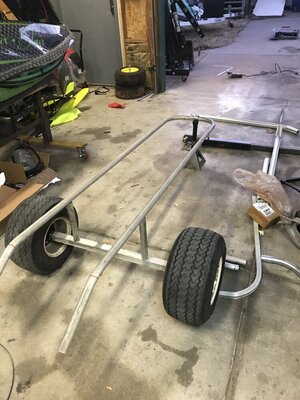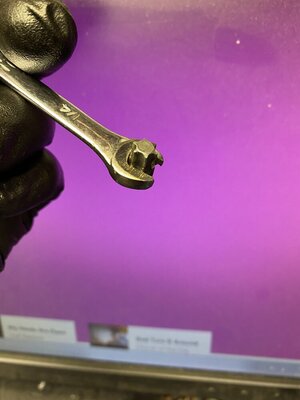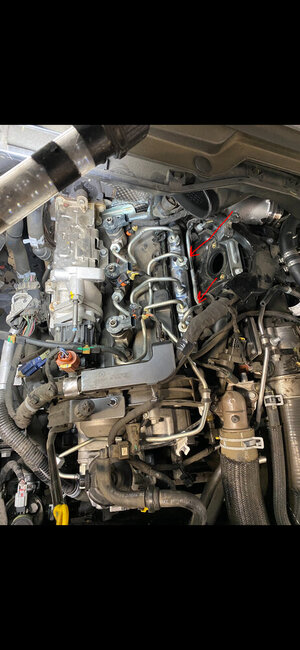- Location
- Wichita ks
You are using an out of date browser. It may not display this or other websites correctly.
You should upgrade or use an alternative browser.
You should upgrade or use an alternative browser.
Other What did you fab up today? A thread for the home fabricators!
- Thread starter OCD Solutions
- Start date
Vumad
Super Hero, with a cape!
- Location
- St. Pete, FL
SLA printers have better resolution, parts especially small ones with fine features come off looking way better from an sla printer. As printed the parts are much more isotropic too. FDM parts can have pretty poor adhesion between layers especially if your temp, speed etc aren't dialed in very well.
How is the strength working out compared to FDM? I have 200 and a 500mm FDM printers but have no experience with SLA.
- Location
- Western NY
Some resins are supposed to be comparable to abs, the only sla parts I've gotten seemed stronger than a pla counterpart, but absorbed moisture eventually and lost all stiffness tuning into almost a flexible part. I dont know what type of resin they were printed from. I'm sure @beerdart has a better idea, I actually ownly own fdm printers at the moment as well.How is the strength working out compared to FDM? I have 200 and a 500mm FDM printers but have no experience with SLA.
OCD Solutions
Original, Clean and Dependable Solutions
- Location
- Rentz, GA
Precisely why I skipped the 3D print fad and invested in a mill and lathe instead.
Speaking of Milling, I finished up the new enclosure and have everything back in place and functioning. A ton of little details and refinement went into this enclosure so the last few days has been quite tedious but rewarding.
Now to start working on the doors...

For comparison, here’s the old enclosure;

Speaking of Milling, I finished up the new enclosure and have everything back in place and functioning. A ton of little details and refinement went into this enclosure so the last few days has been quite tedious but rewarding.
Now to start working on the doors...

For comparison, here’s the old enclosure;

Vumad
Super Hero, with a cape!
- Location
- St. Pete, FL
Some resins are supposed to be comparable to abs, the only sla parts I've gotten seemed stronger than a pla counterpart, but absorbed moisture eventually and lost all stiffness tuning into almost a flexible part. I dont know what type of resin they were printed from. I'm sure @beerdart has a better idea, I actually ownly own fdm printers at the moment as well.
Generally I only use PLA. The ABS has too much warp and delam over the size of the parts I have used. Although I haven't tried ABS again since I have a lot more experience. I do still have warping with PLA on larger stuff, but almost no delamination. Mainly I get my strength from assemblies, using 3-D printed router parts to cut aluminum that I then use with the PLA. It has worked very well.
Precisely why I skipped the 3D print fad and invested in a mill and lathe instead.
I don't think 3D printing is a fad. Like all tools, theres a time and a place for everything. The 3D printed parts are quick and easy with no setup and no waste. The tiny little mount I made for my Wise Cam to monitor my 3D prints was way way simpler to 3D print than to machine.
The DA Vac I sent you, but am not going to post here (cuz it's brilliant and is going to make me ubah rich patent $$) being larger and oddly shaped was much easier to prototype out of plastic instead of milling.
I still think you should get a printer. My Davinci has been hassle free for under $350. Throw it a CAD file and walk away. I got a Wyze Cam and outlet and just kill the power if it starts making spaghetti. Fushion 360 is free. Everyone should try one.
OCD Solutions
Original, Clean and Dependable Solutions
- Location
- Rentz, GA
3D printing just isn’t for me. I gave it some serious thought at one point and even had a bunch of parts made for me and I just wasn’t ever impressed enough with the end result to invest the time or space for one. They are dirt cheap so the money is not the issue.
My next project is to break down the 80/20 extruded framework from my old mill enclosure and re-assemble it into a plasma cutting table that I can then add a gantry and convert to CNC at some point.
After that, or maybe even sooner if the plasma doesn’t pan out like I want, I may skip ahead and invest in a laser table.
Either that or just sell it all off and get back to riding skis...
My next project is to break down the 80/20 extruded framework from my old mill enclosure and re-assemble it into a plasma cutting table that I can then add a gantry and convert to CNC at some point.
After that, or maybe even sooner if the plasma doesn’t pan out like I want, I may skip ahead and invest in a laser table.
Either that or just sell it all off and get back to riding skis...
Vumad
Super Hero, with a cape!
- Location
- St. Pete, FL
I’ve never had a nice shop. For years I worked in a driveway or under tarps. Finally bought a house with a carport but my cabinets and tools rust.
This is my shop I have been working on. 8.5x16x8 V-nose dual axel.
Over the last 2 months I took it apart entirely, wire wheeled any frame rust and painted, siliconed every seam and replace the floor. The floor I packed the edges of the laminate with thickened epoxy to help make sure it wouldn’t rot before deck staining it. Walls are 3/4” ISO board with a 1/4 air gap spaced between the foil and the wall.
I don’t have a garage so this is the home of my new2me g0704 cnc mill and 24x36x6 cnc router. Router came with the wooden stand. Mill wood is something I’m working on.
Walls and ceiling are unfinished, because other than planning to run 220v50a to the trailer for power, I haven’t made any final plans for electrical and lighting.
And Boyer has been a huge help. I’m very fortunate that my new2me mill is the same model and same CAM Boyer has and that he’s been answering some questions.

Sent from my iPhone using Tapatalk
This is my shop I have been working on. 8.5x16x8 V-nose dual axel.
Over the last 2 months I took it apart entirely, wire wheeled any frame rust and painted, siliconed every seam and replace the floor. The floor I packed the edges of the laminate with thickened epoxy to help make sure it wouldn’t rot before deck staining it. Walls are 3/4” ISO board with a 1/4 air gap spaced between the foil and the wall.
I don’t have a garage so this is the home of my new2me g0704 cnc mill and 24x36x6 cnc router. Router came with the wooden stand. Mill wood is something I’m working on.
Walls and ceiling are unfinished, because other than planning to run 220v50a to the trailer for power, I haven’t made any final plans for electrical and lighting.
And Boyer has been a huge help. I’m very fortunate that my new2me mill is the same model and same CAM Boyer has and that he’s been answering some questions.

Sent from my iPhone using Tapatalk
Vumad
Super Hero, with a cape!
- Location
- St. Pete, FL
I think Boyer is super jealous of my enclosure. He won’t admit it, but I know he wishes his had 3D printed parts in his too.


Sent from my iPhone using Tapatalk


Sent from my iPhone using Tapatalk
OCD Solutions
Original, Clean and Dependable Solutions
- Location
- Rentz, GA
I bet he thinks you are about an hour away from realizing how many mistakes you made by building all that before you ever ran a single cycle. 
“A man who holds a cat by its tail learns things he can in no other way”.

“A man who holds a cat by its tail learns things he can in no other way”.
Vumad
Super Hero, with a cape!
- Location
- St. Pete, FL
I bet he thinks you are about an hour away from realizing how many mistakes you made by building all that before you ever ran a single cycle.
“A man who holds a cat by its tail learns things he can in no other way”.
Oh, no, I know. That’s why I went super cheap on the polycarbonate. Just unfortunately because I’m in a trailer with a wood floor and I can’t move anything, I have to try to keep the mess contained from day one.
The mill is the easy part too. The router is going to be a nightmare if I cut wood.
Sent from my iPhone using Tapatalk
OCD Solutions
Original, Clean and Dependable Solutions
- Location
- Rentz, GA
I got the rubber holey mats from Amazon to limit the spread of chips. They help a ton but it still tracks in the house.
Assembly is the easy part. Milling is not as easy as 3D printing. A machinist is a specialized trade all in itself that takes years to learn.
You asked me what feed rate I use for aluminum expecting a simple answer like 2000 inches/min but it's not that simple.
Material, Cutter size, cutter design, # of flutes, depth of cut, direction of travel, rough cut, finish path and that's just the basics.
Next is how much force can you apply to your machine without binding an axis and throwing off your entire DRO system?
How much can you take without cutter galling? Are you planning to run cooling or lube of any kind?
How accurate is your machine? Have you checked positioning accuracy, backlash?
Changes in temperature will affect the step count and needs to be checked and corrected.
Did it come with a Tram gauge?
Assembly is the easy part. Milling is not as easy as 3D printing. A machinist is a specialized trade all in itself that takes years to learn.
You asked me what feed rate I use for aluminum expecting a simple answer like 2000 inches/min but it's not that simple.
Material, Cutter size, cutter design, # of flutes, depth of cut, direction of travel, rough cut, finish path and that's just the basics.
Next is how much force can you apply to your machine without binding an axis and throwing off your entire DRO system?
How much can you take without cutter galling? Are you planning to run cooling or lube of any kind?
How accurate is your machine? Have you checked positioning accuracy, backlash?
Changes in temperature will affect the step count and needs to be checked and corrected.
Did it come with a Tram gauge?
- Location
- native idahoan
You sell those?Another job that took a small bit of time but I spun out a set of improved water screws for my B-pipe. No more set screws breaking off at the ultra thin socket walls. A jamnut combo for additional support and if the hex head strips I can lock the two nuts together for a secondary removal option
Sent from my SM-S767VL using Tapatalk
Vumad
Super Hero, with a cape!
- Location
- St. Pete, FL
I got the rubber holey mats from Amazon to limit the spread of chips. They help a ton but it still tracks in the house.
Assembly is the easy part. Milling is not as easy as 3D printing. A machinist is a specialized trade all in itself that takes years to learn.
You asked me what feed rate I use for aluminum expecting a simple answer like 2000 inches/min but it's not that simple.
Material, Cutter size, cutter design, # of flutes, depth of cut, direction of travel, rough cut, finish path and that's just the basics.
Next is how much force can you apply to your machine without binding an axis and throwing off your entire DRO system?
How much can you take without cutter galling? Are you planning to run cooling or lube of any kind?
How accurate is your machine? Have you checked positioning accuracy, backlash?
Changes in temperature will affect the step count and needs to be checked and corrected.
Did it come with a Tram gauge?
If you want me to answer your questions, you are going to have to ask them in English, K, thanks.
I definitely realize it's not like 3D printing. I'm just busting your chops with that. My 3D printer I plugged it in and went nuts, and 3 years later, I still know a lot less than I want to. This CNC Mill though, I have been sitting down reading anything I can find, constantly afraid I am going to cut my arm off, electrocute myself, catch the place on fire, or more likely, all 3 at the same time. My text questions are mostly based on making sure I don't kill myself or break a part that I can't afford to fix. I expect to be replacing endmills a lot and be a lot more than 3 years in before I feel comfortable.
For speeds and feeds I am going to use a lot of the Fusion360 defaults and see how things go. Fusion calculates the the SFM based on the RPM of the spindle. It uses a default speed of 5000RPM and then SFM = .262 x D x RPM.
The problem I am having with figuring out what to run the machine at is that when I try to search for this information, everyone is giving the same answers, which are, Use Spindle Speed to calculate SFM or to use SFM to calculate spindle speed. I presume this is because each machine is different so no on can give a direct answer because every instance is different. So the only answer I can come up with is to use the fusion defaults, be conservative with plunge depth and see what happens. I can then take a look at the chip sizes and etc and compare them to what I think they should be, I guess.
The tooling and cutter sizes etc are all configured in fusion. It does a lot of default math, but I can adjust the values. Since, all that stuff you said, I am going to have to just run it with the defaults and see what happens, adjusting up or down from there. Bob Ross never had to worry that his painters pallet might kill him though.
I haven't check any of that other stuff you asked about, but I plan to. For right now I'm just trying to get some basic cuts going. I don't know what a TRAM gauge is (Edit: Yes, I have one), but I probably have it. It came with a ton of gauges. That's not important to me yet, as right now I just want to cut out some keychains or something to start learning. My priority presently is safety, precision will come after.
Last night I ran my first G-code file. I didn't put in a tool and didn't turn on the spindle. I set the Z-Axis way above the table and had the G-code running and everything looked like I could attempt to cut something. But today I had my little test piece of aluminum all mounted on my parallel bars ready to cut, was setting up my G-code and etc, and my PSU shut off, so I have no stepper power. It keeps blowing internal fuses, as we discussed. And as is PAR for the course, when I had it open, I was worried about touching a capacitor and dying, cuz that's my luck. I have to assume that I have "dirty" power and it killed my PSU.
So I ordered a new PSU and some more fuses. I'm going to get an UPS, which I had intended to use for the computers anyway but it's not that simple to go to BestBuy right now, and run all the computer stuff on it. I am going to get a 12ga extension cord as well (I think currently I have a 16ga), but the intention was to fully wire the trailer like a shop, so the UPS will stay but the cord will go, being replaced with something more appropriate (garage addition I hope!).
I'm still hoping to salvage the PSU, as the whole package came with extra drivers and steppers, so if I do get this PSU to work, I would be a ethernet board and a case away from another complete controller. I'm not there yet, but trying to be optimistic about already replacing a part.
Last edited:
I amaze myself sometimes...
I usually use black tap to hold a cut off torx bit in my wrench, which works... but today I decided to weld in real quick like....
So I get it done, then discover I welded the wrong bit to the wrench.... damn and that was my only wrench sooooo
Let’s weld the correct bit to the open end of the wrench, oh, let’s weld the bits opposing each other so the wrench can swing.....
Done, perfect, now let’s try it, wtf, the angle is off, the bit should have been welded to the other side of the wrench for better wrench swing clearance...
Should of thought more about what would accurately work better for the job then the aesthetics of the damn wrench lol
It still works, but the tiny bit pokes your palm and the wrench Bartley clears the cylinder head lol..... guess I’ll heat it and correct the bend lol... i need to slow
Down sometimes and think things thru more
I usually use black tap to hold a cut off torx bit in my wrench, which works... but today I decided to weld in real quick like....
So I get it done, then discover I welded the wrong bit to the wrench.... damn and that was my only wrench sooooo
Let’s weld the correct bit to the open end of the wrench, oh, let’s weld the bits opposing each other so the wrench can swing.....
Done, perfect, now let’s try it, wtf, the angle is off, the bit should have been welded to the other side of the wrench for better wrench swing clearance...
Should of thought more about what would accurately work better for the job then the aesthetics of the damn wrench lol
It still works, but the tiny bit pokes your palm and the wrench Bartley clears the cylinder head lol..... guess I’ll heat it and correct the bend lol... i need to slow
Down sometimes and think things thru more
Attachments
OCD Solutions
Original, Clean and Dependable Solutions
- Location
- Rentz, GA
Well done, specific tools for a specific job!
Whats said wrench for?I amaze myself sometimes...
I usually use black tap to hold a cut off torx bit in my wrench, which works... but today I decided to weld in real quick like....
So I get it done, then discover I welded the wrong bit to the wrench.... damn and that was my only wrench sooooo
Let’s weld the correct bit to the open end of the wrench, oh, let’s weld the bits opposing each other so the wrench can swing.....
Done, perfect, now let’s try it, wtf, the angle is off, the bit should have been welded to the other side of the wrench for better wrench swing clearance...
Should of thought more about what would accurately work better for the job then the aesthetics of the damn wrench lol
It still works, but the tiny bit pokes your palm and the wrench Bartley clears the cylinder head lol..... guess I’ll heat it and correct the bend lol... i need to slow
Down sometimes and think things thru more
Whats said wrench for?
Fuel rail hold down bolts on the 3.0L Eco diesel in dodge & Jeep vehicles. It’s a 40 torx bolt and there is no room for standard tools with intake manifold in the way. see red arrows... The Factory tool broke on first use....
Attachments
Last edited:
- Location
- California
Does it still count if it’s nerd stuff?




There was a big silver monolith last weekend but when we got there today someone had ripped it out.
We were going for this....





There was a big silver monolith last weekend but when we got there today someone had ripped it out.
We were going for this....

Big Kahuna
Administrator
- Location
- Tuscaloosa, AL
I just got one question. When are the storm troopers going to go to marksmanship school? They still cannot hid the broadside of a barn if they are .000000000000000039 parsecs away....Does it still count if it’s nerd stuff?




There was a big silver monolith last weekend but when we got there today someone had ripped it out.
We were going for this....

Last edited:








